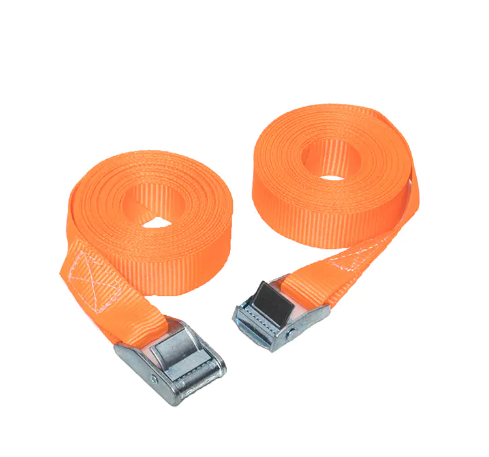No.2 new District Minglun Village,Wuxiang Town,Yinzhou District
-

Tel: +86 18658447778
-

E-mail: [email protected]
-


Material selection: Industrial-grade cam buckle strapping usually uses high-density polyester fiber (Polyester) or nylon (Nylon) webbing, with a tensile strength of up to 1,000~5,000 kg (depending on the specifications), wear resistance and tear resistance.
Metal parts: Cam buckles and hooks are mostly galvanized steel or aluminum alloy, which are rust-proof and have strong load-bearing capacity, suitable for outdoor or humid environments.
Quick fastening: One-way locking through the lever-type cam mechanism, no complex tools are required, and one person can quickly complete the bundling.
One-button release: Press the cam buckle to instantly release the webbing, which is more efficient than traditional bolt or chain bundling.
Strong adjustability: The length of the webbing can be freely adjusted to adapt to loads of different sizes (such as pipes, plates, equipment).
Anti-loosening design: The cam mechanism bites the webbing through a toothed structure, which is not easy to slide under vibration or impact, and avoids loosening during transportation.
Load stability: Evenly distribute pressure to reduce damage to the surface of the goods (such as not strangling soft materials).
Weather resistance: UV resistant, high and low temperature resistant (-40℃~80℃), suitable for sea transportation, open-air storage and other scenarios.
Chemical resistance: Polyester webbing is oil-resistant, acid-resistant and alkali-resistant, suitable for corrosive environments such as chemicals and oil fields.
Reusable: Compared with disposable strapping, industrial-grade cam buckle straps have a long life and reduce long-term costs.
Easy to maintain: After being dirty, it can be rinsed with water or detergent and reused after drying.
Logistics and transportation: fix goods in trucks and containers.
Construction sites: bundle steel bars and scaffolding materials.
Aviation/shipping: fix deck equipment or aviation equipment.
Agriculture/Energy: Secure farm machinery, pipelines, or wind turbine blades.
Compared with traditional bundling methods
|
Features |
Cam buckle strapping |
Chain/bolt |
Regular plastic strapping |
|
Installation speed |
Fast (<30 seconds) |
Slow (tools required) |
Fast but low strength |
|
Vibration resistance |
Excellent |
Excellent (but prone to wear and tear) |
Poor |
|
Cost effectiveness |
Medium to high (long-term reuse) |
High (high maintenance cost) |
Low (disposable) |
Cam self-locking mechanism (core principle)
Working principle:
When the strap is tightened, the cam (metal or high-strength plastic) compresses the webbing under the action of the lever to form a self-locking.
The greater the external force, the stronger the bite force of the cam on the webbing to prevent rebound and loosening.
Key structural optimization:
Tooth cam: Increase the friction coefficient to avoid slippage (smooth cams common in low-end products are prone to failure).
Spring assistance: Some high-end models have built-in stainless steel springs to ensure that the cam always fits the webbing.
Webbing guide system (anti-eccentric load design)
Low-end products are prone to local stress concentration and accelerated wear due to webbing skew.
High-end designs use **"V-shaped guide grooves" or "roller guides"** to ensure that the webbing is evenly stressed.
Durability of the release button
Cheap products use plastic buttons, which are prone to breakage after long-term pressing.
The industrial-grade cam buckle uses a metal button + spring reset, supporting more than 100,000 operations.
Pain Point: In the transportation of large molds, traditional chain fixation is time-consuming and easy to scratch the surface of the equipment.
Solution:
Use 3-ton cam buckle straps + corner protectors to complete the fixation in 10 minutes (originally 30 minutes).
No metal friction, protect the mold coating.
Pain Point: The bumps in sea transportation cause the cargo in the box to shift, triggering cargo damage claims.
Solution:
The cross-type cam buckle strap fixation method is used, and the looseness rate is reduced by 90% through tension sensor monitoring.
Pain Point: Frequent adjustment of straps is required during high-altitude operations, which poses a safety hazard.
Solution:
The cam buckle strap that can be operated with one hand, combined with the anti-fall hook, increases the installation efficiency by 40%.